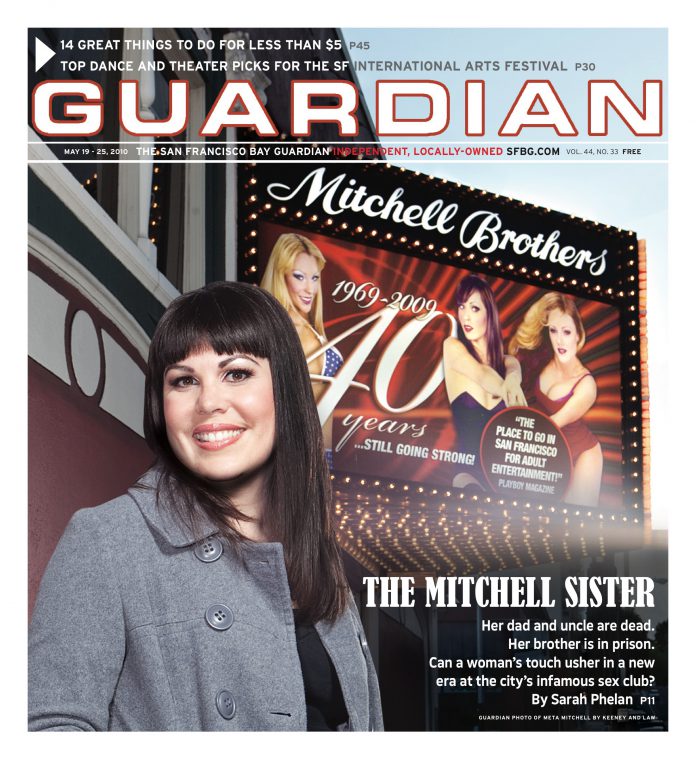arts@sfbg.com
FILM/VISUAL ART The first time I witnessed Walter Funk’s Hologlyphics, I’d spiraled up the whimsical stairs of Jaina Bee’s Granny’s Empire of Art, parted curtains and slipped inside the otherwise dark, slanted-roof attic. A circle floated in the center of the room that slowly morphed into a rhombus, then a rectangle. It was three-dimensional, but not real. Along with its movement, sound spread from keyboards and motion-sensor instruments and bounced off the walls.
Remember when R2-D2 projected Princess Leia’s message “Help me, Obi-Wan Kenobi. You’re my only hope”? What was once just an idea imagined by George Lucas is now Walter Funk’s Hologlyphics — although the images are abstract and more like Leia’s famous coiled buns. Unlike the 3-D technology Avatar is hyping, Hologlyphics requires no glasses and presents a 90-degree view of the object, allowing a viewer to walk around the image and see it from multiple perspectives.
Funk developed a system for live auto-stereoscopic movies along with music and created a family of real-time spatial image synthesis and processing algorithms that he has coined Hologlyphics. The system takes information from keyboards, controllers, motion sensors, and acoustic instruments and projects a 3-D image that interacts with the sound it is simultaneously producing. “So as something gets bigger and smaller, something might get louder or softer or lower or higher in pitch,” Funk explains as we talk over a café americano (him) and black coffee (me) at the Marsh Café. “The sound and the visual are considered one thing. For every visual, there’s an associated sound, just like in the real world.”
Funk has been pursuing holography ever since he went to the now defunct Museum of Holography in New York in the 1980s. In 1987, he ordered his first holography kit and played with graphics on the now-ancient Apple IIe. But he kept running into walls and was frustrated by monetary and technological constraints. He considered abandoning his work. Then, in the early 1990s while doing research in old technical journals, he discovered Homer Tilton’s display system and got in touch with Tilton.
“He [Tilton] was really open to the idea of doing art with his parallactiscope system, even though it wasn’t what he did,” Funk explains. “He actually put together some early hardware for me. Here I was, this freaky artist in California. And he didn’t necessarily share my same visual aesthetic, but just liked the idea that people wanted to do other stuff with his display.” By 1994, with the aide of Tilton, Funk had put together his first prototype.
Currently the display projects green, morphing, 3-D shapes. But Funk has big dreams for the future — although there are still the same two limitations: money and technology. In an ideal future, the system would be “larger, full color, and photo-realistic.” If the system was larger, multiple people could view it at a time — just like Avatar. But for now, Hologlyphics works best as a one-person-at-a-time experience. “Everything I’m doing is pretty much abstract, which is good, since I’m doing a lot of abstract music,” Funk says. “At the same time, I’d like people to incorporate real-world imagery with it.”
Funk has an optimistic view of the latest 3-D craze. “There are some negative aspects because some studios are just going make things 3-D to make money. But there’s a whole new world of storytelling going on. Done right, it can be amazing and even evolve into a different art form beyond film.”
With Funk’s system, viewers witness multiple perspectives while moving, just like the hologlyph, thus integrating it fluidly into the real world. “This is a cheesy example, but everyone knows it,” he says, with more energy than a mere cafe americano can provide. “Imagine Clint Eastwood when he says, ‘Go ahead, make my day.’ What if you were watching that movie for the first time, and right at that scene you’re looking at the back of his head because you can — that takes away a lot of effect and power from the filmmaker. It’s not a bad thing or a good thing. It’s just a different art form.”
Hologlyphics illustrates the potential for enhanced viewing experiences and new ways to tell stories. “The thought of it is very common, but the existence of it is not,” he says. “I think once this stuff does exist, there’s no putting it back. It’s like Pandora’s box — people are gonna love it.”
WALTER FUNK’S HOLOGLYPHICS
Maker Faire
Sat/22, 10 a.m.–8 p.m.; Sun/23, 10 a.m.–6 p.m.; free–$25
San Mateo County Event Center
346 Saratoga Drive, San Mateo (650) 574-3247

